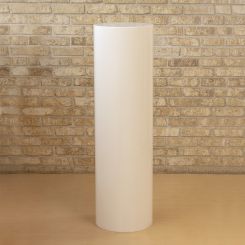A common struggle with setting up an art gallery display is having to make do with a small amount of space. But it’s worth it to do it right: Art sales in the United States have increased by 33% to $28 billion in 2021, according to the 2022 Art Basel and UBS Global Art Market Report. Here, we provide guidance and tips for how to make the most of a small space along with some ideas of how to use shopPOPdisplays’ acrylic display products to set it all up.
When it comes to creating art gallery displays, there are several things to consider, including the space’s layout, lighting, and decor, to help maximize the space. The main purpose of an art gallery is to showcase—and sell—art so their design should help visitors not only navigate an exhibit to view but also encourage purchases. First, we’ll discuss creating art galleries from the ground up and then we’ll help maximize the space by suggesting products from shopPOPdisplays’ inventory of in-stock acrylic frames, displays, pedestals, and more to make your art gallery a success. Interested in something specific and not mentioned here? No problem. Contact us for custom options.
Create a Preliminary Sketch to Approximate Scale
Sketching your art gallery’s space on graphing paper (even roughly) can help you make the best use of the space. Take a good look at the raw space and note any problematic elements you don’t have control over, like sloped walls, a bank of windows, or open doorways that will make it difficult to showcase art. Then, note the positive features such as an expansive wall, a separate storage space, outlets, or restrooms. Now, list what’s missing. Don’t forget about a reception or lounge area.
After taking stock of all these elements, create a final sketch that’s true to scale incorporating fixtures, lighting, outlets, thermostats (for optimal temperature and humidity levels), and sound system equipment.
Consider Traffic Flow
Consider the direction you want patrons to move in your space. Map it out on your sketch (just like an IKEA store map). When deciding where to place larger features like your reception desk or lounge seating, opt for areas that are visible, yet not interrupting the exhibit in any way. For example, a welcome desk should be up front in the space and not obscuring wall space that may be needed to hang art; a lounge can be placed toward the end of an exhibit to entice people to stay and discuss the artwork or speak with the artist regarding purchases after they’ve viewed the exhibit.
For larger features that display art, such as floating walls and pedestals, place them in convenient spots along the path the patrons will be following. Depending on the piece of art, consider placing a pedestal against a wall, in a corner, or in the middle of the room. For instance, a sculpture that has multiple views depending on vantage point should be displayed in the center of a room.
Design with Safety Regulations in Mind
Check with local officials to determine safety regulations you need to include in your plan. For instance, the International Building Code generally requires at least two means of egress from all spaces and buildings, but may have some exceptions. You’ll need to know if the space meets accessibility requirements and if not, what you’ll need to do to meet them.
Play with Scale Rather Than Symmetry
Think about where and how you’ll display the artwork. While it’s true the symmetry can be soothing on the eyes, it can be a little boring when it comes to art gallery displays. If you have a group of paintings that work particularly well together, arrange them in a tighter cluster to make a statement. Also know that eye level doesn’t have to mean uniform-sized frames in a neat row. Matted artwork in a variety of different-sized frames can be displayed—just center each image at eye level (about 62 inches from the floor) for a display that demands attention without detracting attention from individual pieces.
Opt for Minimalism
Keep your decor simple with minimal distractions. Art galleries are usually white for a reason. White walls provide a crisp backdrop for all types of art and allows the art to be the focus. Keep in mind, however, when displaying art on pedestals, the pedestal needs to match or complement the artwork, not the room.

Six Display Ideas for Art Galleries
- Prevent damage to fragile, high-value art with an acrylic display case
Protect art pieces from dust, sunlight, and other damage by displaying in an acrylic frame or an acrylic display case. ShopPOPdisplays offers a variety of sizes to choose from, including display boxes with bases, mirrored boxes, lighted display cases, wall mount display cases, and locking display cases.
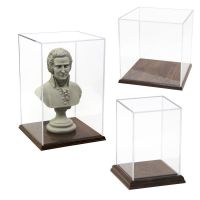
- Choose an acrylic riser or display pedestal to showcase petite art
Smaller objects, such as jewelry and pottery, can be artfully arranged on an acrylic riser or featured on a display pedestal. Drape a necklaces or scarf over an acrylic block riser; or set a ring on top or in an acrylic cylinder riser. Pottery and ceramics can be placed on acrylic pedestals. Pedestals are available in assorted colors, shapes, and sizes ranging, from clear acrylic and colors to cylinder and square shapes, to floor standing and tabletop to full custom.
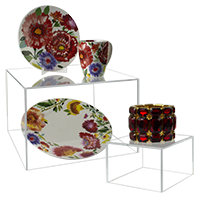
- Select a wall-mount display case to maximize floor space
If your space is too narrow to use pedestals, consider wall mount display cases. ShopPOPdisplays’ wall mount display cases are lighter than glass, making them a clear choice for hanging artwork in a smaller gallery. Acrylic also bests glass in that it is shatterproof, optically clear, insulating, and cost-effective. What’s more, wall-mounted pedestals—available in many shapes, sizes, colors, and finishes—can help maximize floor space to make a room appear larger than it is. They can also add depth to a gallery wall
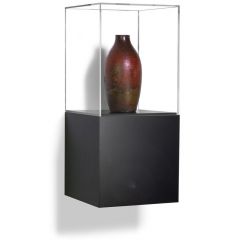
- Make proportions of room larger by using display pedestals
Small space? You can still incorporate pedestals into your art gallery. Specifically, round pedestals, as their shape minimizes their appearance. Their softer shape also helps balance out a room that has angular shapes. Clear acrylic pedestals are smart choices in smaller spaces. Their transparency allows them to blend into the room.

- Combine acrylic risers and pedestals together to create more height
We’ve already mentioned the importance of displays being placed at eye level. However, feel free to employ acrylic risers and pedestals to provide a sense of height and interest. This is also necessary if your pedestals are the same height as other surfaces in the room, such as a couch or table, or even other pedestals. If you have a grouping of pedestals, they should vary in size. If not, add risers to elevate the artwork.
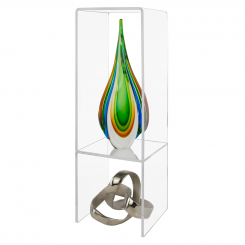
- Tell guests what they’re looking at
Informational directional signage is necessary in any space. We have a variety of sign holders to help title and describe artwork, including wall mount top loading acrylic sign holders and acrylic poster stands.
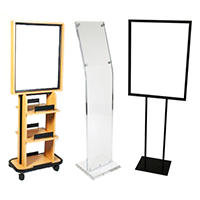
At shopPOPdisplays, we have an extensive selection of display cases, frames, pedestals, and risers to maximize space in art galleries. We also offer custom sizing and printing options to expertly outfit your gallery. Our skilled craftspeople and expert engineers have knowledge in designing displays. Contact us to discuss, we’ll gladly assist you.





